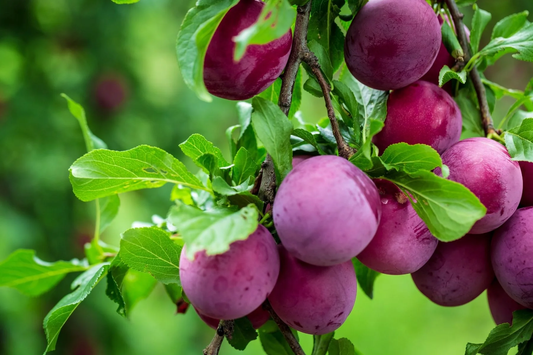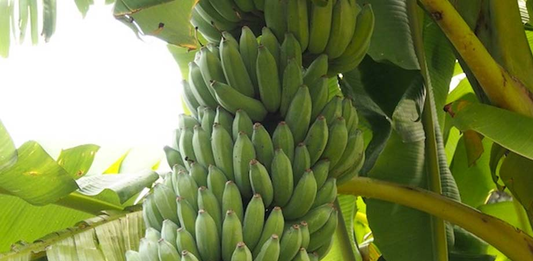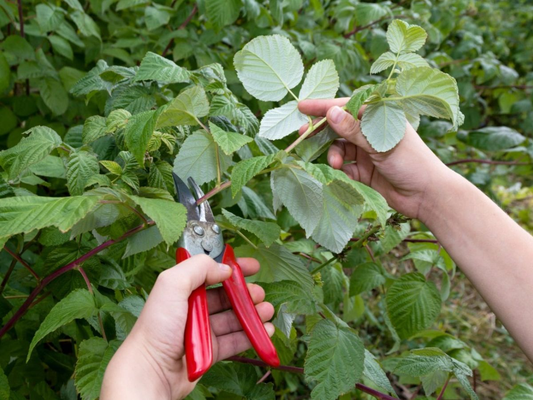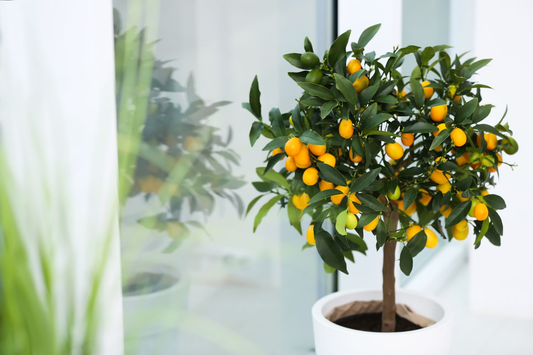Berry Good Times: How to Grow Blueberries in Containers with Ease!
Share
Table of Contents
1. Introduction
Blueberries are one of the most beloved fruits worldwide, known not only for their deliciously sweet and tangy flavor but also for their numerous health benefits. Packed with vitamins, antioxidants, and dietary fiber, these little berries are often hailed as a superfood, making them a favorite among health-conscious individuals and culinary enthusiasts alike.
Growing blueberries in containers offers several advantages, especially for those with limited space or who live in urban environments. Here are some key benefits:
- Space Efficiency: Container gardening allows you to grow blueberries on balconies, patios, or small yards.
- Control Over Soil Conditions: You can create the ideal acidic soil mix that blueberries thrive in.
- Mobility: Containers can be moved to take advantage of sunlight or protect plants from harsh weather.
- Less Pest Pressure: Growing in containers can reduce pest problems compared to traditional garden beds.
- Extended Growing Season: Containers can be brought indoors or protected from frost, allowing for earlier planting and longer harvesting periods.
In this article, you can expect to learn:
- The different varieties of blueberries suitable for container gardening.
- How to choose the right container and soil for optimal growth.
- Step-by-step planting techniques and maintenance tips.
- Best practices for watering, fertilizing, and pruning your blueberry plants.
- How to identify and manage pests and diseases that may affect your blueberries.
- Harvesting tips to enjoy your homegrown blueberries at their peak.
Whether you're a beginner or an experienced gardener looking to expand your container garden, this guide will provide you with all the information you need to grow blueberries successfully and enjoy the delightful fruits of your labor!

2. Understanding Blueberry Varieties
When it comes to growing blueberries, understanding the different types available is crucial for successful cultivation, especially in containers. There are three main types of blueberries:
-
Highbush Blueberries:
- Typically grow 4 to 6 feet tall.
- Most common type cultivated commercially.
- Requires more chill hours, making them suitable for temperate regions.
-
Lowbush Blueberries:
- Generally grow 1 to 2 feet tall.
- Known for their hardy nature and ability to withstand colder temperatures.
- Often used for wild blueberry production and have a more intense flavor.
-
Rabbiteye Blueberries:
- Grow well in warmer climates, reaching heights of 6 to 12 feet.
- More tolerant of heat and drought than other types.
- Requires cross-pollination for better fruit set, so planting multiple varieties is recommended.
When selecting the best varieties for container gardening, consider the following:
- Size of the Variety: Choose smaller varieties for containers, such as:
- Top Hat: A compact highbush variety, reaching only 1 to 2 feet tall.
- Sunshine Blue: A semi-dwarf variety, ideal for smaller spaces.
- Jelly Bean: A small, compact variety perfect for containers.
- Climate Compatibility: Consider your local climate:
- Highbush varieties thrive in cooler areas.
- Rabbiteye varieties are best for warmer, southern climates.
- Lowbush varieties can withstand cold but may need protection in harsh winters.
- Space Considerations: Ensure the container can accommodate the root system:
- Use larger pots (at least 5 gallons) for highbush varieties.
- Smaller varieties can thrive in pots as small as 2 gallons.
3. Choosing the Right Container
Selecting the right container for your blueberries is essential for their growth and overall health. Here are some suitable types of containers:
-
Pots:
- Commonly available in various materials such as plastic, clay, and ceramic.
- Ensure they have drainage holes to prevent waterlogging.
-
Barrels:
- Wooden or plastic barrels can provide ample space for root growth.
- They add a rustic aesthetic to your garden.
-
Fabric Grow Bags:
- Promote excellent drainage and aeration for the roots.
- Lightweight and easy to move around as needed.
-
Self-Watering Containers:
- Help maintain consistent moisture levels, which blueberries prefer.
- Reduce the frequency of watering, especially in hot weather.
When choosing a container, consider the following:
-
Drainage:
- Good drainage is crucial to prevent root rot.
- Containers should have multiple drainage holes at the bottom.
-
Size:
- Minimum size recommendations for container blueberries:
- At least 5 gallons for highbush varieties.
- 2 to 3 gallons for dwarf varieties.
- Larger containers provide more space for root growth and moisture retention.
-
Aesthetic Considerations:
- Choose containers that complement your outdoor decor.
- Consider color, style, and material to enhance your garden's visual appeal.
- Group containers together for a more cohesive look.

4. Ideal Soil Conditions
Creating the right soil conditions is crucial for the successful growth of blueberries. These plants thrive in acidic soils, which offer the optimal environment for nutrient absorption. Here are the essential soil requirements:
-
Soil Acidity:
- Blueberries prefer acidic soil with a pH level between 4.5 and 5.5.
- Soils with a pH above 6.0 can lead to nutrient deficiencies.
-
Soil Texture:
- A well-draining soil mixture is vital to prevent root rot.
- Soil should retain moisture while allowing excess water to escape.
For container blueberries, consider the following recommended soil mixtures:
-
Commercially Available Acidic Potting Mix:
- Look for potting mixes specifically formulated for acid-loving plants.
- These mixes usually contain pine bark, peat moss, and perlite.
-
DIY Soil Mix:
- Combine equal parts of peat moss, pine bark fines, and perlite.
- Add a handful of sulfur to increase acidity if needed.
To enhance soil conditions and promote healthy growth, consider these tips:
-
Soil Amendments:
- Incorporate elemental sulfur to lower pH levels.
- Use pine needles as mulch to naturally acidify the soil over time.
-
Fertilizers:
- Opt for fertilizers formulated for acid-loving plants, such as those containing ammonium sulfate.
- Apply fertilizers in early spring and mid-summer for best results.
By ensuring the right soil conditions, you can provide a strong foundation for your blueberries, enabling them to flourish in their container environment.
5. Planting Blueberries in Containers
Planting blueberries in containers is a rewarding endeavor, allowing you to enjoy fresh berries even in limited space. Follow this step-by-step guide to ensure successful planting:
Step-by-Step Guide
-
Gather Your Materials:
- Choose a suitable container (at least 5 gallons for highbush varieties).
- Select the right soil mix (acidic potting mix or DIY blend).
- Have mulch (like pine bark or wood chips) ready for covering the soil surface.
-
Prepare the Container:
- Ensure the container has drainage holes to prevent waterlogging.
- Fill the container with the prepared soil mix, leaving about 2 inches of space at the top.
-
Choose Healthy Plants:
- Select young blueberry plants from a reputable nursery.
- Look for plants that are disease-free with healthy roots and foliage.
-
Planting:
- Remove the blueberry plant from its nursery pot.
- Gently loosen any tightly bound roots to encourage growth.
- Dig a hole in the center of the container that is deep enough to accommodate the root ball.
- Place the plant in the hole, ensuring that the top of the root ball is level with the soil surface.
- Fill in around the roots with soil, pressing gently to eliminate air pockets.
-
Watering:
- Thoroughly water the newly planted blueberries until water drains from the bottom.
- Maintain consistent moisture, especially during the first few weeks.
-
Mulching:
- Add a layer of mulch to help retain moisture and regulate soil temperature.
- Pine needles are an excellent choice as they also help acidify the soil over time.
Recommended Planting Techniques
- Depth: Ensure the root ball is level with the soil surface to prevent water from pooling around the crown.
- Spacing: If planting multiple blueberries in one container, ensure they are spaced at least 2 feet apart to allow for proper growth and airflow.
Importance of Companion Planting
Companion planting can significantly enhance your blueberry garden by providing pest control and promoting biodiversity. Consider planting the following:
-
Herbs:
- Basil and thyme can repel pests while attracting beneficial insects.
- Mint can deter harmful pests but should be contained to prevent overgrowth.
-
Flowers:
- Marigolds help repel nematodes and other harmful pests.
- Lavender attracts pollinators and can deter deer and rabbits.

6. Watering and Maintenance
Proper watering and maintenance are essential for the health and productivity of your container-grown blueberries. Here are key guidelines to follow:
Guidelines for Watering Blueberries in Containers
-
Frequency:
- Water blueberries regularly, aiming for 1 to 2 inches of water per week.
- Adjust frequency based on weather conditions, especially during hot, dry spells.
- Check the soil moisture every few days; containers may dry out faster than in-ground plants.
-
Amount:
- Water deeply to encourage strong root development.
- Apply enough water until it drains from the bottom of the container.
- Use a moisture meter or your finger to test soil moisture before watering.
Signs of Overwatering and Underwatering
Monitoring your plants for signs of stress can help you identify watering issues:
-
Overwatering:
- Yellowing leaves, especially older leaves.
- Wilting despite wet soil; roots may be rotting.
- Fungal growth or mold on the soil surface.
-
Underwatering:
- Leaves appear dry and crispy, especially at the edges.
- Wilting or drooping leaves, especially during hot weather.
- Stunted growth and poor fruit production.
General Maintenance Tips
In addition to watering, general maintenance is crucial for healthy blueberry plants:
-
Weeding:
- Regularly check for weeds that compete for nutrients and moisture.
- Hand-pull weeds or use mulch to suppress their growth.
-
Mulching:
- Apply a layer of mulch (2 to 4 inches) to help retain soil moisture and regulate temperature.
- Pine bark or wood chips are excellent choices, as they also help acidify the soil.
-
Pruning:
- Prune annually to remove dead or damaged branches and encourage healthy growth.
- Focus on thinning out crowded areas to improve air circulation.
7. Fertilizing Blueberries
Fertilizing your container-grown blueberries is essential for providing the nutrients they need to thrive and produce abundant fruit. Here’s how to effectively fertilize your plants:
Best Organic Fertilizers for Blueberries
-
Organic Fertilizer Options:
-
Acidic Fertilizers: Use fertilizers specifically formulated for acid-loving plants. Options include:
- Blood meal: High in nitrogen and helps acidify the soil.
- Fish emulsion: A balanced nutrient source with trace elements.
- Bone meal: Provides phosphorus for strong root development.
- Compost: Well-aged compost adds organic matter and nutrients to the soil. Incorporate it into the top layer of soil in the container.
- Pine Needles: Adding a layer of pine needles as mulch not only helps retain moisture but also gradually acidifies the soil.
-
Acidic Fertilizers: Use fertilizers specifically formulated for acid-loving plants. Options include:
When and How to Fertilize for Optimal Growth
-
Timing:
- Fertilize in early spring, just as new growth begins to emerge.
- A second application can be made in mid-summer to support fruit development.
-
Application Method:
- Follow the manufacturer’s instructions for application rates on commercial fertilizers.
- For organic options, a handful of fertilizer spread evenly over the soil surface can be effective.
- Water thoroughly after applying fertilizer to help it penetrate the soil and reach the roots.
Importance of Monitoring Nutrient Levels
Regularly monitoring nutrient levels is critical to ensuring your blueberries receive adequate nourishment:
-
Soil Testing:
- Conduct a soil test every couple of years to check pH levels and nutrient availability.
- Adjust your fertilization practices based on test results to maintain optimal soil conditions.
-
Visual Indicators:
- Yellowing leaves may indicate nitrogen deficiency; consider adjusting your fertilization schedule.
- Poor fruit production or stunted growth may signal a need for additional nutrients.

8. Sunlight and Temperature Requirements
To grow healthy blueberries in containers, understanding their sunlight and temperature requirements is crucial. Here are the key factors to consider:
Ideal Sunlight Conditions for Blueberries
-
Sunlight Exposure:
- Blueberries thrive in full sun, requiring at least 6 to 8 hours of direct sunlight daily.
- Optimal sunlight promotes strong growth, flowering, and fruit production.
-
Sunlight Positioning:
- Position containers in a spot that receives morning sun to help dry off any dew and reduce disease risk.
- Avoid placing them in areas with heavy shade or obstructions that block sunlight for extended periods.
Understanding Temperature Needs and Protection Strategies
-
Temperature Tolerance:
- Blueberries prefer temperate climates, thriving in temperatures between 60°F and 75°F (15°C to 24°C).
- They can tolerate cooler temperatures, but extreme heat above 85°F (29°C) can hinder fruit set.
-
Protection Strategies:
- During extreme heat, provide shade cloth or relocate containers to cooler areas.
- In colder climates, protect plants by moving containers to sheltered spots during winter months.
- Consider using frost blankets if frost is forecasted in early spring or late fall.
Tips for Growing in Shaded Areas
If you have limited sunlight exposure, consider the following strategies:
-
Partial Shade Varieties:
- Choose blueberry varieties that are more tolerant of partial shade, such as some highbush varieties.
-
Maximizing Light:
- Position containers where they can receive the most light, such as near walls or reflective surfaces.
- Prune surrounding plants to minimize shade and increase light access to your blueberries.
9. Pruning Blueberries for Better Yield
Pruning is a vital practice for maintaining the health and productivity of container-grown blueberries. Here’s what you need to know about effective pruning:
Importance of Pruning for Container-Grown Blueberries
-
Encourages New Growth:
- Pruning helps stimulate new growth, leading to more fruit-bearing branches.
- It removes old, less productive wood, making way for healthier, more vigorous shoots.
-
Improves Air Circulation:
- Thinning out crowded branches enhances air circulation, reducing the risk of disease.
- Better airflow allows sunlight to reach more parts of the plant, improving overall health.
When and How to Prune Effectively
-
Timing:
- Prune in late winter or early spring, just before new growth begins.
- This timing ensures minimal shock to the plant and promotes robust growth in the growing season.
-
Pruning Techniques:
- Use sharp, clean pruning shears to make clean cuts and avoid damaging the plant.
- Focus on:
- Removing dead or damaged branches.
- Thinning out crowded growth to maintain an open center.
- Cutting back one-third of the oldest stems to encourage new growth.
Tips for Maintaining Plant Health and Productivity
-
Regular Monitoring:
- Inspect plants regularly for signs of disease or pest issues that may require immediate attention.
- Prune any diseased branches promptly to prevent spread.
-
Balanced Fertilization:
- Complement pruning with proper fertilization to support new growth.
- Maintain soil acidity and nutrient levels for optimal plant health.

10. Common Pests and Diseases
Container-grown blueberries can be susceptible to various pests and diseases. Understanding these challenges and implementing preventive measures is crucial for maintaining plant health. Here’s an overview:
Overview of Common Pests
-
Aphids:
- Small, soft-bodied insects that can cause stunted growth and distorted leaves.
- They feed on plant sap and can transmit diseases.
-
Spider Mites:
- Tiny arachnids that thrive in hot, dry conditions.
- Symptoms include yellowing leaves and fine webbing on the plant.
-
Blueberry Maggots:
- Larvae can damage fruit, leading to premature dropping or rotting.
- Look for small, pinhole-like marks on the berries.
Signs of Disease and Prevention Methods
-
Common Diseases:
- Powdery Mildew: White, powdery spots on leaves. Can lead to leaf drop if not managed.
- Leaf Spot: Dark, irregular spots on leaves that may cause yellowing and early leaf drop.
-
Prevention Methods:
- Ensure proper air circulation by pruning crowded branches.
- Water at the base of the plant to avoid wetting the foliage, reducing disease risk.
- Rotate pots or change their location to minimize pest infestations.
Organic Pest Control Solutions for Container Blueberries
-
Neem Oil:
- Effective against aphids and spider mites. Mix with water and spray on affected areas.
-
Insecticidal Soap:
- Targets soft-bodied pests. Apply directly to the pests for best results.
-
Companion Planting:
- Planting herbs like basil or marigolds nearby can repel pests naturally.
11. Harvesting Blueberries
Harvesting blueberries at the right time and with care is essential to enjoy their full flavor and quality. Here’s what you need to know:
Signs of Ripeness and Optimal Harvesting Time
-
Color Change:
- Blueberries should be a deep blue color; any red or green tinge indicates they are not yet ripe.
- Look for a dull finish on the berries, which indicates ripeness.
-
Season:
- Harvest typically occurs in mid to late summer, depending on the variety.
- Check daily as berries can ripen quickly.
Tips for Harvesting Blueberries Without Damaging Plants
-
Gentle Handling:
- Use your fingers to gently roll the berries off the stems.
- Avoid pulling hard on the berries, which can damage the plant.
-
Harvest in the Morning:
- Early morning is ideal as the berries are cooler and firmer, reducing the risk of damage.
Storing and Using Freshly Harvested Blueberries
-
Storage:
- Store blueberries in the refrigerator for up to a week.
- Avoid washing them until ready to use to prevent spoilage.
-
Usage:
- Enjoy fresh in smoothies, salads, or desserts.
- Consider freezing excess berries for later use; spread them on a baking sheet to freeze individually before transferring to a container.
12. Conclusion
In summary, growing blueberries in containers offers a rewarding experience with numerous benefits. We covered:
- The importance of selecting the right varieties.
- Choosing appropriate containers and ideal soil conditions.
- Essential care practices such as watering, fertilizing, and pruning.
- Recognizing pests and diseases for effective management.
- Harvesting tips to enjoy your blueberries at their best.
Now is the perfect time to start your container blueberry garden. Enjoy the process and the delicious rewards!
13. FAQ - Frequently Asked Questions
-
1. What size container is best for growing blueberries?
- A container with a minimum volume of 5 gallons is recommended for optimal root growth.
- Larger containers (10 gallons or more) provide better stability and moisture retention.
-
2. How often should I water blueberries in containers?
- Water regularly, ensuring the soil remains consistently moist but not waterlogged.
- Typically, this means watering every 2-3 days, more frequently in hot weather.
-
3. Can I grow blueberries indoors?
- Yes, blueberries can be grown indoors if they receive sufficient light (at least 6 hours of sunlight per day).
- Consider using grow lights if natural light is inadequate.
-
4. What do I do if my blueberries aren’t producing fruit?
- Ensure proper pollination; consider planting multiple varieties for cross-pollination.
- Check for nutrient deficiencies and soil pH; blueberries thrive in acidic soil (pH 4.5 to 5.5).
-
5. Are there specific pests I should watch out for?
- Common pests include aphids, spider mites, and blueberry maggots.
- Monitor your plants regularly for signs of these pests to take timely action.
Additional Resources
How to Care for Indoor Ferns: Lighting, Watering, and More Essential T – XRoci
Charming Indoor Gardening Ideas for Small Spaces: Cultivating Beauty a – XRoci
How to Grow Tomatoes: A Flavorful Adventure Awaits in Your Garden! – XRoci
How to Plant Grass Seed: The Essential Guide for a Beautiful Yard – XRoci




